2022 HYUNDAI SANTA CRUZ service
[x] Cancel search: servicePage 503 of 598
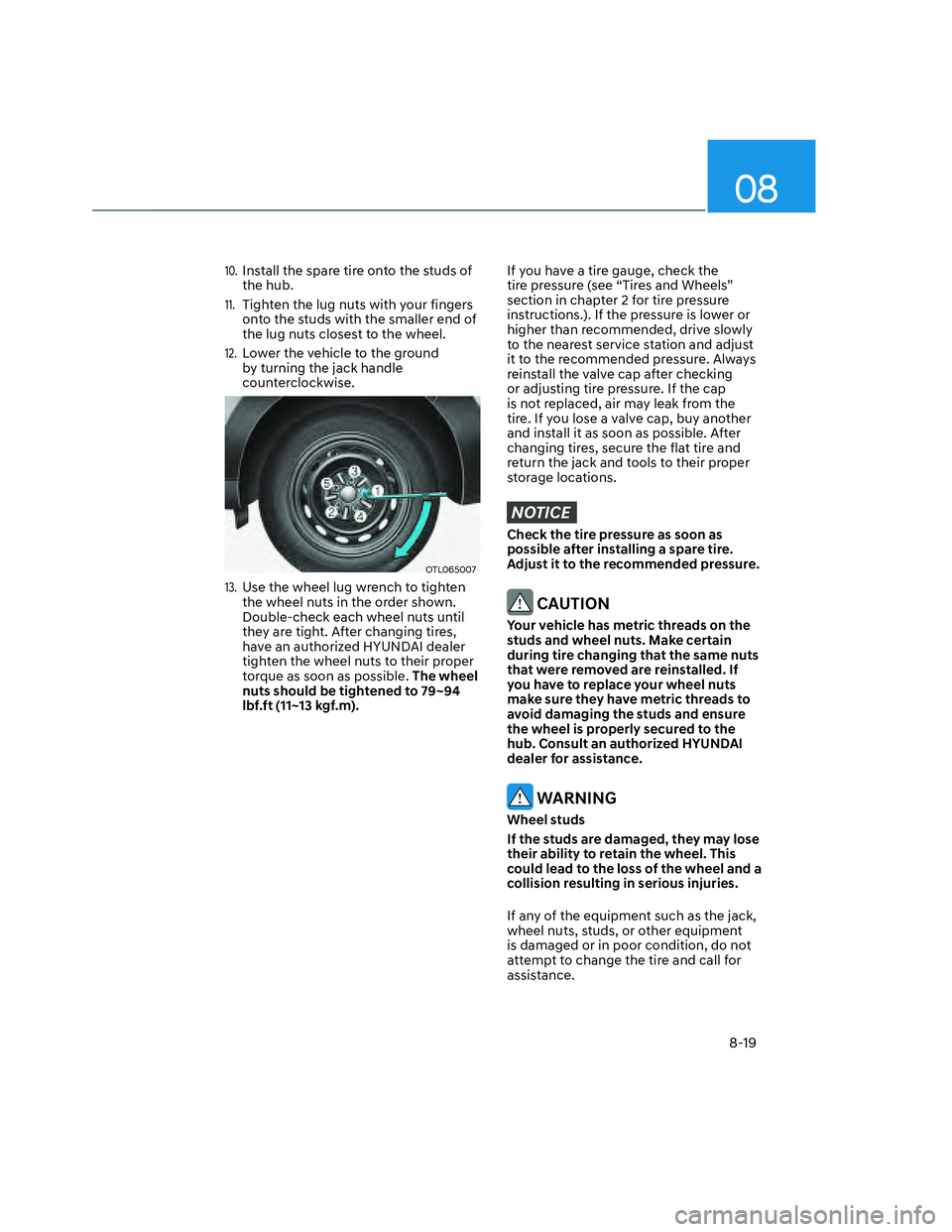
08
8-19
10. Install the spare tire onto the studs of
the hub.
11. Tighten the lug nuts with your fingers
onto the studs with the smaller end of
the lug nuts closest to the wheel.
12. Lower the vehicle to the ground
by turning the jack handle
counterclockwise.
OTL065007OTL065007
13. Use the wheel lug wrench to tighten
the wheel nuts in the order shown.
Double-check each wheel nuts until
they are tight. After changing tires,
have an authorized HYUNDAI dealer
tighten the wheel nuts to their proper
torque as soon as possible. The wheel
nuts should be tightened to 79~94
lbf.ft (11~13 kgf.m).
If you have a tire gauge, check the
tire pressure (see “Tires and Wheels”
section in chapter 2 for tire pressure
instructions.). If the pressure is lower or
higher than recommended, drive slowly
to the nearest service station and adjust
it to the recommended pressure. Always
reinstall the valve cap after checking
or adjusting tire pressure. If the cap
is not replaced, air may leak from the
tire. If you lose a valve cap, buy another
and install it as soon as possible. After
changing tires, secure the flat tire and
return the jack and tools to their proper
storage locations.
NOTICE
Check the tire pressure as soon as
possible after installing a spare tire.
Adjust it to the recommended pressure.
CAUTION
Your vehicle has metric threads on the
studs and wheel nuts. Make certain
during tire changing that the same nuts
that were removed are reinstalled. If
you have to replace your wheel nuts
make sure they have metric threads to
avoid damaging the studs and ensure
the wheel is properly secured to the
hub. Consult an authorized HYUNDAI
dealer for assistance.
WARNING
Wheel studs
If the studs are damaged, they may lose
their ability to retain the wheel. This
could lead to the loss of the wheel and a
collision resulting in serious injuries.
If any of the equipment such as the jack,
wheel nuts, studs, or other equipment
is damaged or in poor condition, do not
attempt to change the tire and call for
assistance.
Page 505 of 598
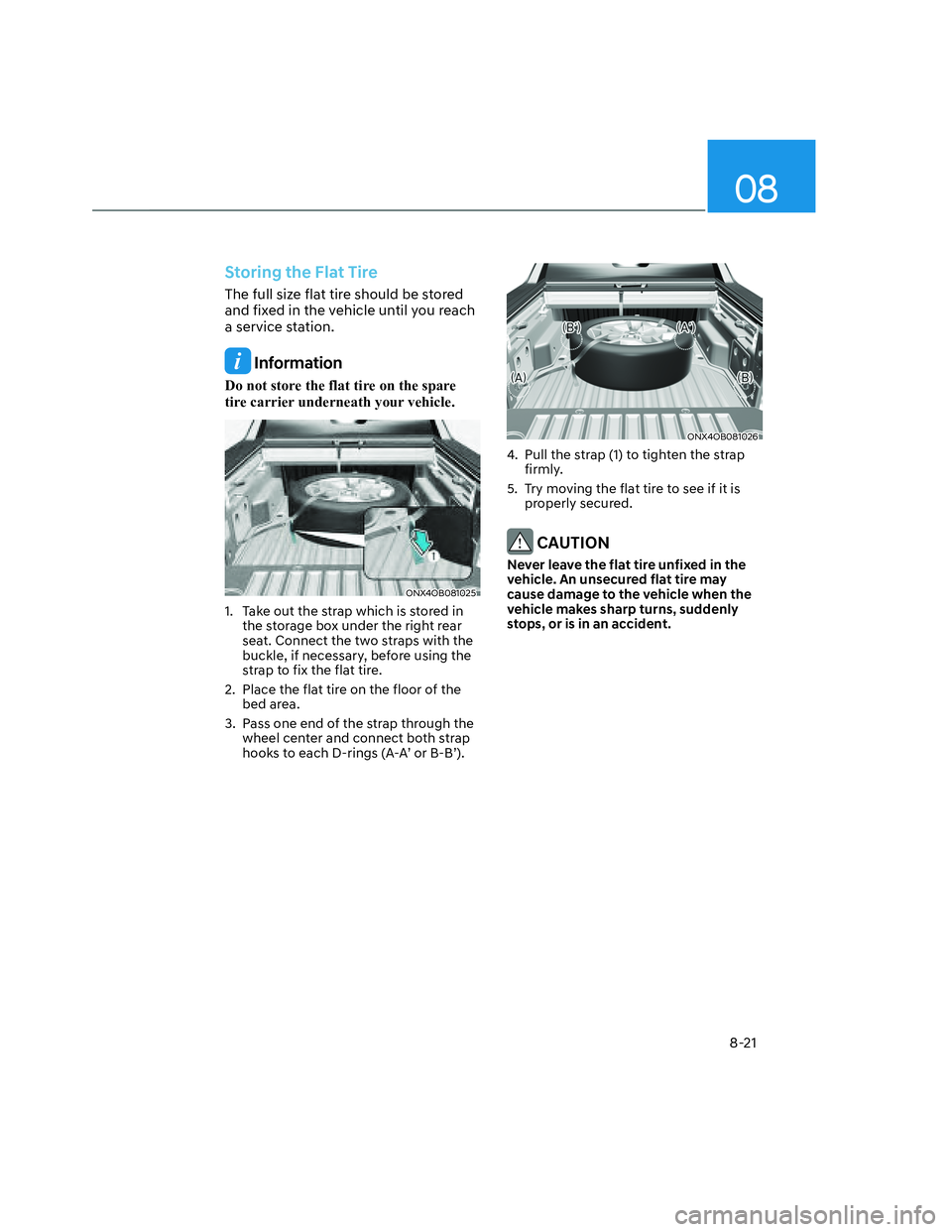
08
8-21
Storing the Flat Tire
The full size flat tire should be stored
and fixed in the vehicle until you reach
a service station.
Information
Do not store the flat tire on the spare
tire carrier underneath your vehicle.
ONX4OB081025ONX4OB081025
1. Take out the strap which is stored in
the storage box under the right rear
seat. Connect the two straps with the
buckle, if necessary, before using the
strap to fix the flat tire.
2. Place the flat tire on the floor of the
bed area.
3. Pass one end of the strap through the
wheel center and connect both strap
hooks to each D-rings (A-A’ or B-B’).
ONX4OB081026ONX4OB081026
4. Pull the strap (1) to tighten the strap
firmly.
5. Try moving the flat tire to see if it is
properly secured.
CAUTION
Never leave the flat tire unfixed in the
vehicle. An unsecured flat tire may
cause damage to the vehicle when the
vehicle makes sharp turns, suddenly
stops, or is in an accident.
Page 507 of 598
![HYUNDAI SANTA CRUZ 2022 Owners Manual 08
8-23
TOWING
Towing Service
A
ONX4OB081016ONX4OB081016[A] : Dollies
If emergency towing is necessary,
we recommend having it done by
an authorized HYUNDAI dealer or a
commercial tow-truck service HYUNDAI SANTA CRUZ 2022 Owners Manual 08
8-23
TOWING
Towing Service
A
ONX4OB081016ONX4OB081016[A] : Dollies
If emergency towing is necessary,
we recommend having it done by
an authorized HYUNDAI dealer or a
commercial tow-truck service](/manual-img/35/41171/w960_41171-506.png)
08
8-23
TOWING
Towing Service
A
ONX4OB081016ONX4OB081016[A] : Dollies
If emergency towing is necessary,
we recommend having it done by
an authorized HYUNDAI dealer or a
commercial tow-truck service.
Proper lifting and towing procedures
are necessary to prevent damage to
the vehicle. The use of wheel dollies or
flatbed is recommended.
For FWD vehicles, it is acceptable to tow
the vehicle using a tow truck as long as
the front wheels (which are the drive
wheels) are off the ground. The rear
wheels can be on the ground without the
use of dollies.
For AWD vehicles, all wheels must be off
the ground. Therefore, a flat bed trailer is
recommended.
If any of the loaded wheels or suspension
components are damaged or the vehicle
is being towed with the rear wheels on
the ground, use a towing dolly under the
rear wheels.
When being towed by a commercial tow
truck and wheel dollies are not used,
the front of the vehicle should always be
lifted, not the rear.
For AWD vehicles, it must be towed
with a wheel lift and dollies or flatbed
equipment with all the wheels off the
ground.
NOTICE
Do not lift the vehicle by the tow fitting
or body and chassis parts. Otherwise
the vehicle may be damaged.
CAUTION
• Do not tow the vehicle with the front
wheels on the ground as this may
cause damage to the vehicle.
ONX4OB081017ONX4OB081017
• Do not tow with sling-type
equipment. Use wheel lift or flatbed
equipment.
ONX4OB081018ONX4OB081018
Page 509 of 598
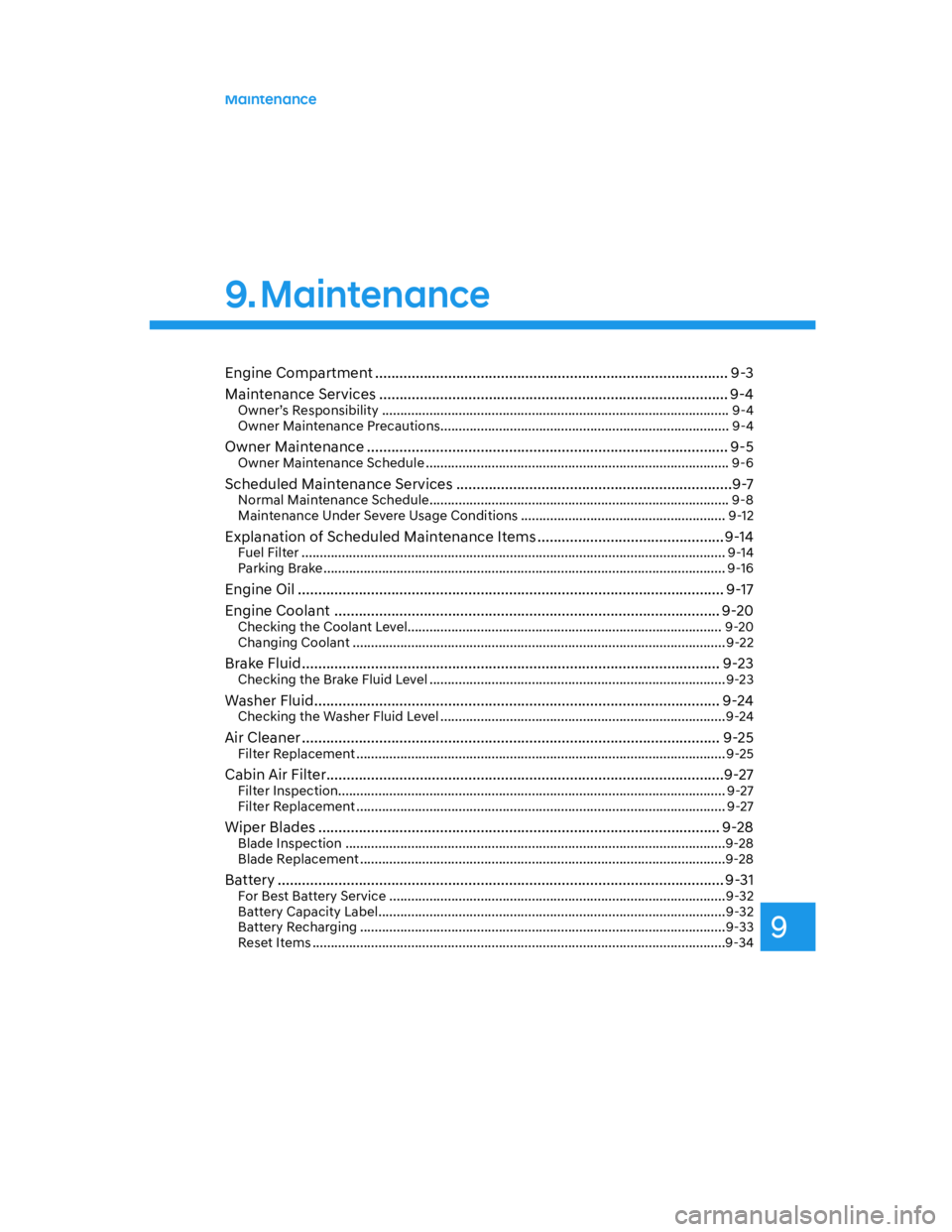
9
Maintenance
9. Maintenance
Engine Compartment ....................................................................................... 9-3
Maintenance Services ...................................................................................... 9-4
Owner’s Responsibility ............................................................................................... 9-4
Owner Maintenance Precautions ............................................................................... 9-4
Owner Maintenance ......................................................................................... 9-5Owner Maintenance Schedule ................................................................................... 9-6
Scheduled Maintenance Services ....................................................................9-7
Normal Maintenance Schedule .................................................................................. 9-8
Maintenance Under Severe Usage Conditions ........................................................ 9-12
Explanation of Scheduled Maintenance Items .............................................. 9-14Fuel Filter ....................................................................................................................9-14
Parking Brake .............................................................................................................. 9-16
Engine Oil ......................................................................................................... 9-17
Engine Coolant ............................................................................................... 9-20
Checking the Coolant Level...................................................................................... 9-20
Changing Coolant ...................................................................................................... 9-22
Brake Fluid ....................................................................................................... 9-23Checking the Brake Fluid Level ................................................................................. 9-23
Washer Fluid .................................................................................................... 9-24Checking the Washer Fluid Level ..............................................................................9-24
Air Cleaner ....................................................................................................... 9-25Filter Replacement ..................................................................................................... 9-25
Cabin Air Filter ..................................................................................................9-27Filter Inspection.......................................................................................................... 9-27
Filter Replacement ..................................................................................................... 9-27
Wiper Blades ................................................................................................... 9-28Blade Inspection ........................................................................................................9-28
Blade Replacement ....................................................................................................9-28
Battery .............................................................................................................. 9-31For Best Battery Service ............................................................................................ 9-32
Battery Capacity Label ............................................................................................... 9-32
Battery Recharging ....................................................................................................9-33
Reset Items .................................................................................................................9-34
Page 512 of 598
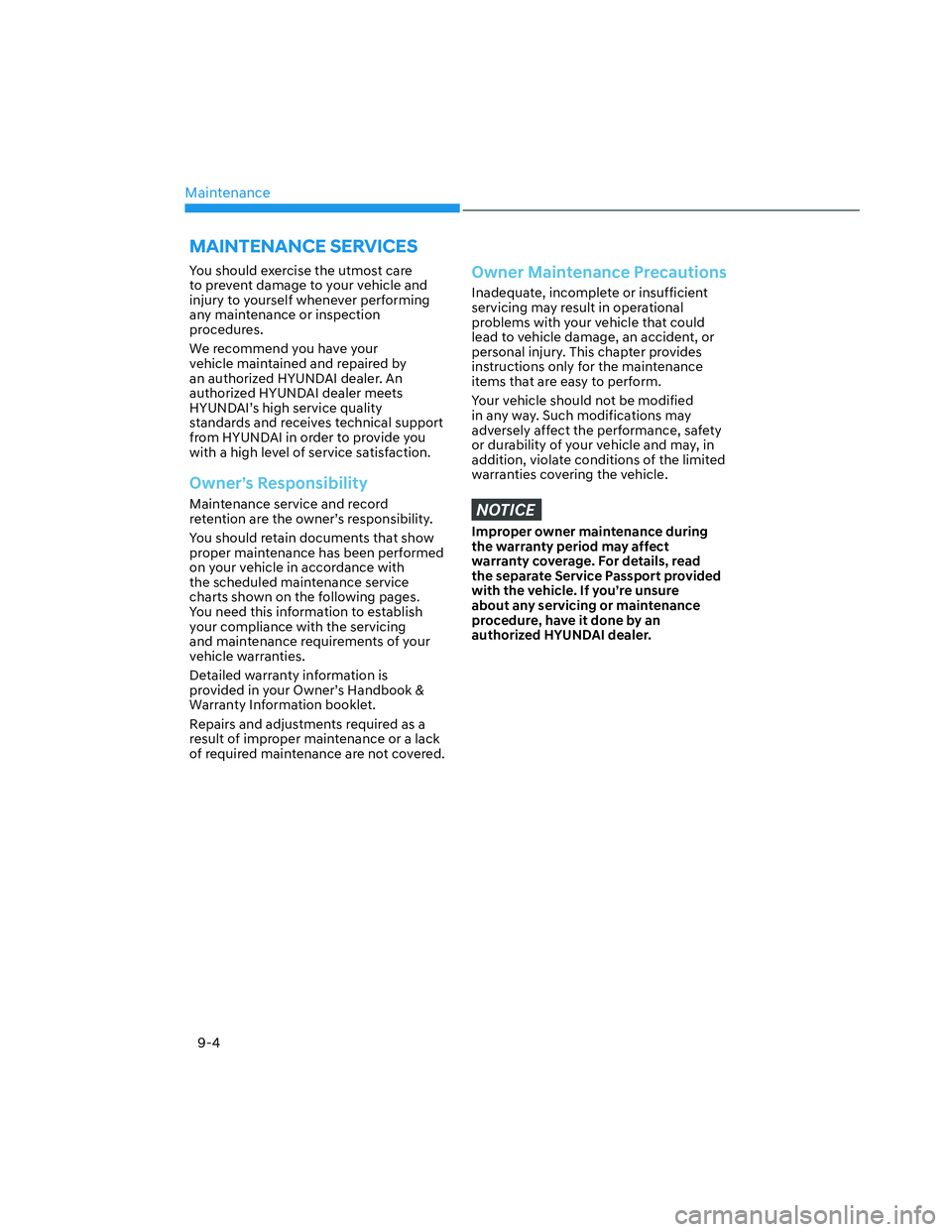
Maintenance
9-4
You should exercise the utmost care
to prevent damage to your vehicle and
injury to yourself whenever performing
any maintenance or inspection
procedures.
We recommend you have your
vehicle maintained and repaired by
an authorized HYUNDAI dealer. An
authorized HYUNDAI dealer meets
HYUNDAI’s high service quality
standards and receives technical support
from HYUNDAI in order to provide you
with a high level of service satisfaction.
Owner’s Responsibility
Maintenance service and record
retention are the owner’s responsibility.
You should retain documents that show
proper maintenance has been performed
on your vehicle in accordance with
the scheduled maintenance service
charts shown on the following pages.
You need this information to establish
your compliance with the servicing
and maintenance requirements of your
vehicle warranties.
Detailed warranty information is
provided in your Owner’s Handbook &
Warranty Information booklet.
Repairs and adjustments required as a
result of improper maintenance or a lack
of required maintenance are not covered.
Owner Maintenance Precautions
Inadequate, incomplete or insufficient
servicing may result in operational
problems with your vehicle that could
lead to vehicle damage, an accident, or
personal injury. This chapter provides
instructions only for the maintenance
items that are easy to perform.
Your vehicle should not be modified
in any way. Such modifications may
adversely affect the performance, safety
or durability of your vehicle and may, in
addition, violate conditions of the limited
warranties covering the vehicle.
NOTICE
Improper owner maintenance during
the warranty period may affect
warranty coverage. For details, read
the separate Service Passport provided
with the vehicle. If you’re unsure
about any servicing or maintenance
procedure, have it done by an
authorized HYUNDAI dealer.
MAINTENANCE SERVICES
Page 515 of 598
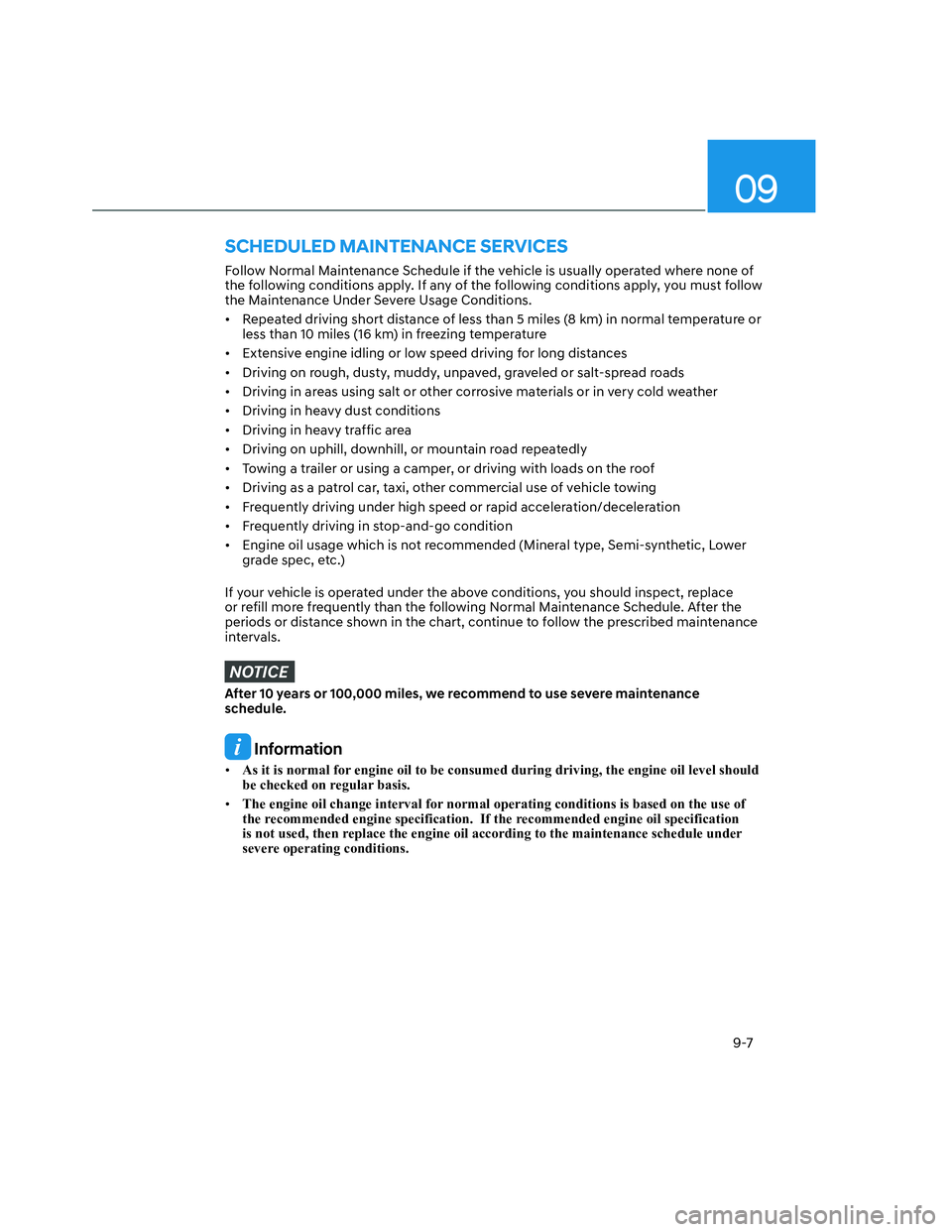
09
9-7
Follow Normal Maintenance Schedule if the vehicle is usually operated where none of
the following conditions apply. If any of the following conditions apply, you must follow
the Maintenance Under Severe Usage Conditions.
• Repeated driving short distance of less than 5 miles (8 km) in normal temperature or
less than 10 miles (16 km) in freezing temperature
• Extensive engine idling or low speed driving for long distances
• Driving on rough, dusty, muddy, unpaved, graveled or salt-spread roads
• Driving in areas using salt or other corrosive materials or in very cold weather
• Driving in heavy dust conditions
• Driving in heavy traffic area
• Driving on uphill, downhill, or mountain road repeatedly
• Towing a trailer or using a camper, or driving with loads on the roof
• Driving as a patrol car, taxi, other commercial use of vehicle towing
• Frequently driving under high speed or rapid acceleration/deceleration
• Frequently driving in stop-and-go condition
• Engine oil usage which is not recommended (Mineral type, Semi-synthetic, Lower
grade spec, etc.)
If your vehicle is operated under the above conditions, you should inspect, replace
or refill more frequently than the following Normal Maintenance Schedule. After the
periods or distance shown in the chart, continue to follow the prescribed maintenance
intervals.
NOTICE
After 10 years or 100,000 miles, we recommend to use severe maintenance
schedule.
Information
• As it is normal for engine oil to be consumed during driving, the engine oil level should
be checked on regular basis.
• The engine oil change interval for normal operating conditions is based on the use of
the recommended engine specification. If the recommended engine oil specification
is not used, then replace the engine oil according to the maintenance schedule under
severe operating conditions.
SCHEDULED MAINTENANCE SERVICES
Page 519 of 598
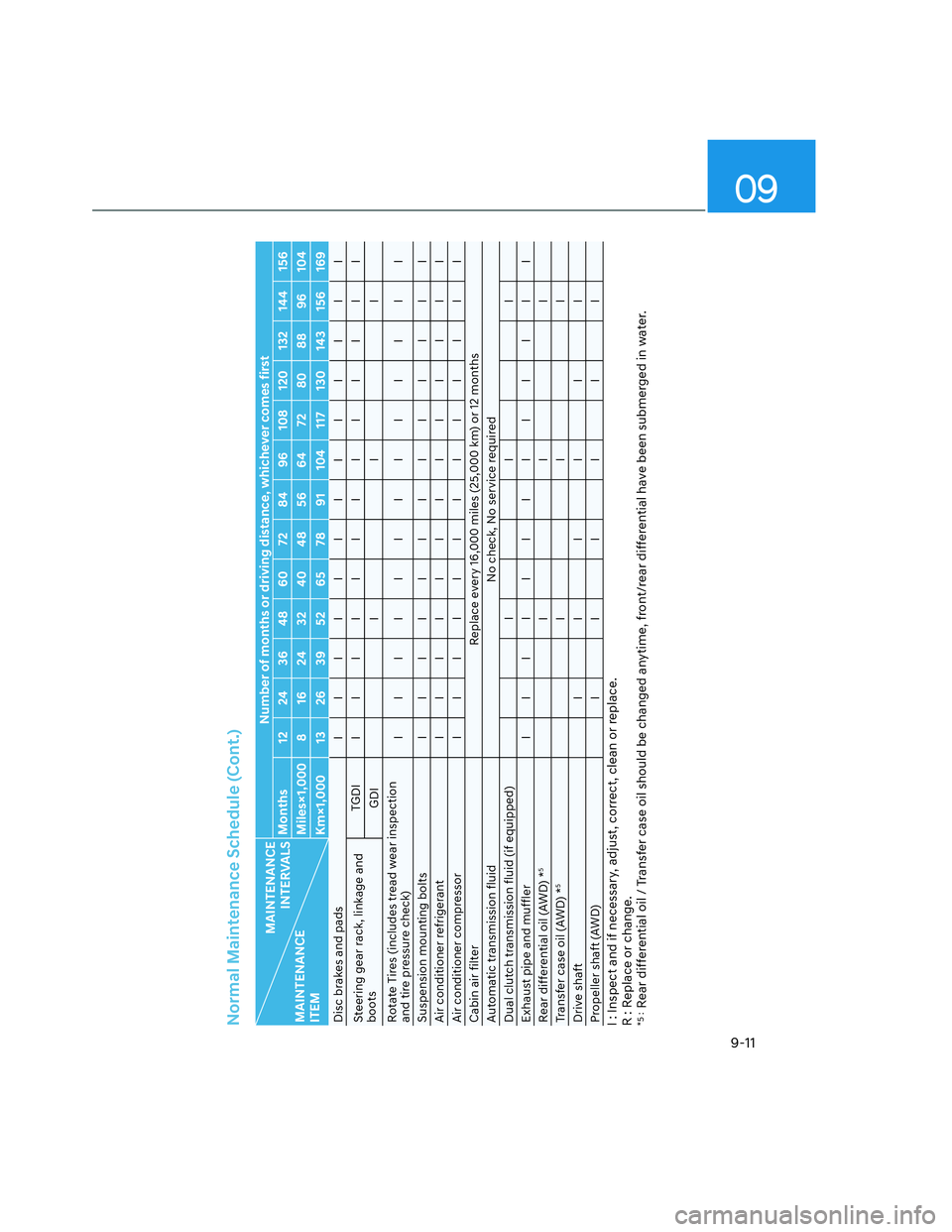
09
9-11
Normal Maintenance Schedule (Cont.)
MAINTENANCE
INTERVALS
MAINTENANCE
ITEMNumber of months or driving distance, whichever comes first
Months 12 24 36 48 60 72 84 96 108 120 132 144 156
Miles×1,000 8 16 24 32 40 48 56 64 72 80 88 96 104
Km×1,000 13 26 39 52 65 78 91 104 117 130 143 156 169
Disc brakes and padsIIIIIIIIIIIII
Steering gear rack, linkage and
bootsTGDI IIIIIIIIIIIII
GDI I I I
Rotate Tires (includes tread wear inspection
and tire pressure check)IIIIIIIIIIIII
Suspension mounting boltsIIIIIIIIIIIII
Air conditioner refrigerantIIIIIIIIIIIII
Air conditioner compressorIIIIIIIIIIIII
Cabin air filter Replace every 16,000 miles (25,000 km) or 12 months
Automatic transmission fluid No check, No service required
Dual clutch transmission fluid (if equipped) I I I
Exhaust pipe and mufflerIIIIIIIIIIIII
Rear differential oil (AWD) *
5
III
Transfer case oil (AWD) *
5
III
Drive shaft IIIIII
Propeller shaft (AWD)IIIIII
I : Inspect and if necessary, adjust, correct, clean or replace.
R : Replace or change.*5 :
Rear differential oil / Transfer case oil should be changed anytime, front/rear differential have been submerged in water.
Page 520 of 598
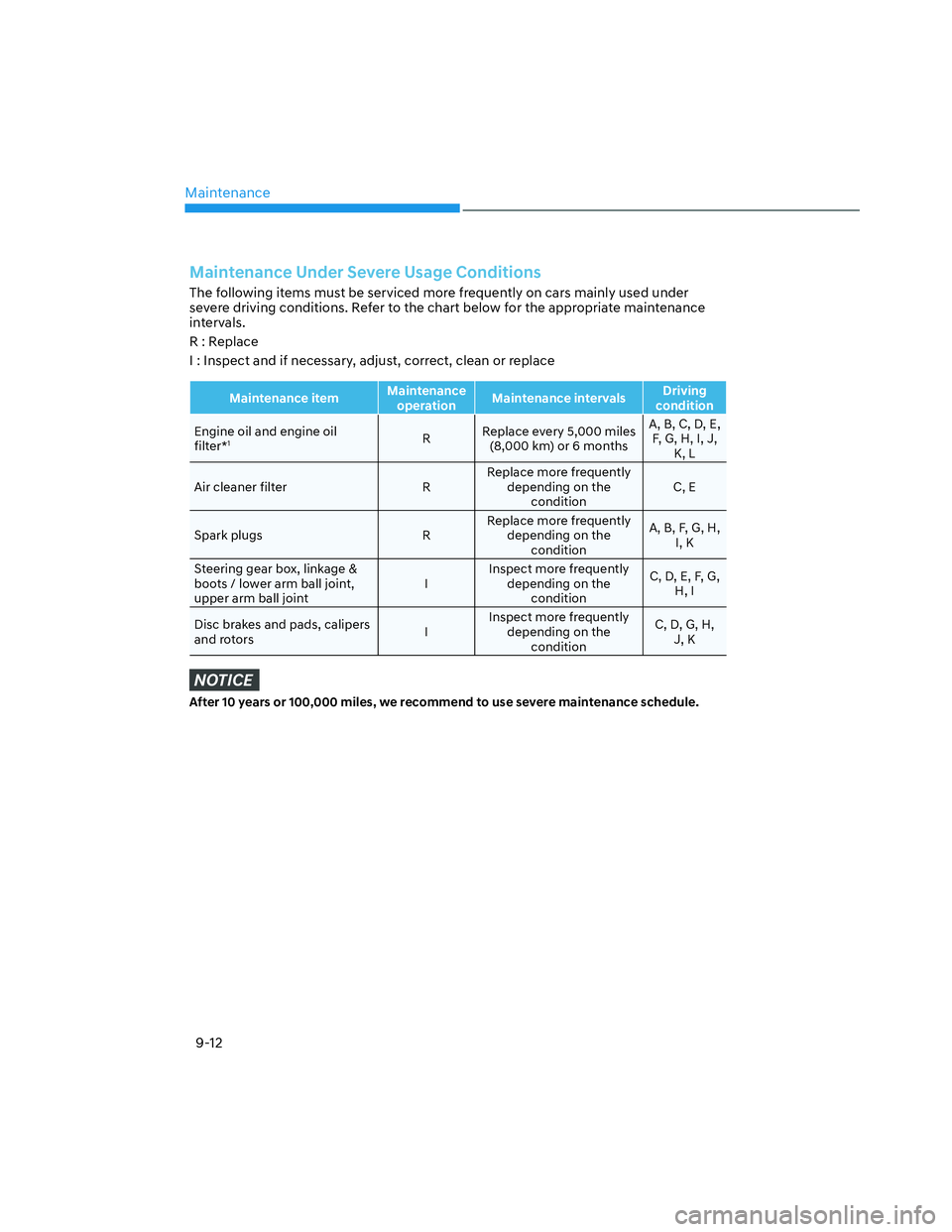
Maintenance
9-12
Maintenance Under Severe Usage Conditions
The following items must be serviced more frequently on cars mainly used under
severe driving conditions. Refer to the chart below for the appropriate maintenance
intervals.
R : Replace
I : Inspect and if necessary, adjust, correct, clean or replace
Maintenance itemMaintenance
operationMaintenance intervalsDriving
condition
Engine oil and engine oil
filter*1RReplace every 5,000 miles
(8,000 km) or 6 monthsA, B, C, D, E,
F, G, H, I, J,
K, L
Air cleaner filter RReplace more frequently
depending on the
conditionC, E
Spark plugs RReplace more frequently
depending on the
conditionA, B, F, G, H,
I, K
Steering gear box, linkage &
boots / lower arm ball joint,
upper arm ball jointIInspect more frequently
depending on the
conditionC, D, E, F, G,
H, I
Disc brakes and pads, calipers
and rotorsIInspect more frequently
depending on the
conditionC, D, G, H,
J, K
NOTICE
After 10 years or 100,000 miles, we recommend to use severe maintenance schedule.